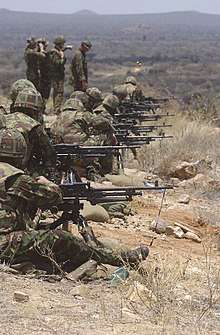Weapons company
A weapons company, sometimes called a manoeuvre support company, is a company-sized military unit attached to an infantry battalion to support the rifle companies of the battalion.[1] It usually possesses some combination of machine-guns, mortars, anti-tank missiles, anti-aircraft missiles, reconnaissance vehicles and, sometimes, assault pioneers (infantrymen specially trained in the assault role).
British Army

In the British army, the manoeuvre support company possesses an Anti-Tank platoon armed with Javelin, a reconnaissance platoon, a mortar platoon (with eight 81 mm mortars), an assault pioneer platoon, and, in the case of Light Role battalions, a machine gun platoon (with nine GPMGs).
United States Marine Corps
In the United States Marine Corps, the infantry battalion weapons company is tasked with providing supporting fire for the three rifle companies that (along with the battalion's headquarters and service company) make up the remaining balance of the battalion. The weapons company provides organic fire support coordination, mortar, anti-armor, and heavy machine gun support.
The company is often organized into four distinct elements: company headquarters, mortar platoon (utilizing the M252 81mm mortar), anti-armor platoon (utilizing the FGM-148 Javelin and BGM-71 TOW missile systems), and a heavy machine gun platoon (equipped with the M2 .50 caliber machinegun, and MK-19 40mm automatic grenade launcher).
The company headquarters consists of the company commander (CO), executive officer (XO), first sergeant, operations chief, property NCO, and two drivers.
The mortar platoon is organized with a five-man platoon headquarters (platoon commander, platoon sergeant, ammunition technician, and two ammunition men) and two 32-man mortar sections. Each mortar section contains an eight-man section headquarters, which includes a section leader, two ammunition men, and a fire direction center with two forward observers (FOs), and four six-man mortar squads. Each mortar squad includes a squad leader, a gunner, assistant gunner, and three ammunition men. The platoon's two sections are often placed in direct support of one of the two forward rifle companies (using the Marine Corps' standard "two up, one back" tactical disposition doctrine, which places two maneuver elements forward with one maneuver element behind, allowing for exploiting an attack or reinforcing a defense). The FOs are attached (along with a radio operator from the mortar party in the battalion's communication platoon) to one of the battalion's rifle companies or rifle platoons.
The anti-armor platoon contains a small platoon headquarters (platoon commander, platoon sergeant, and driver), an anti-armor (Javelin missile system) section, and a TOW (heavy anti-tank missile system) section. The anti-armor section is usually dismounted and consists of a section leader and two eight-man anti-armor squads, each divided into two four-man teams equipped with two missile launchers each. The anti-armor section is usually attached by squad to one of the two forward rifle companies, with one team attached to each of the two forward rifle platoons. The TOW section consists of a section leader and driver/radio operator and four five-man TOW squads. Each TOW squad has a squad leader, two gunners, and two assistant gunners/drivers and is equipped with two TOW launchers and two vehicles.
In addition to a small platoon headquarters (platoon commander, platoon sergeant, and two ammunition men/drivers), the heavy machine gun platoon has three eight-man heavy machine gun sections, each consisting of two four-man squads consisting of a squad leader, gunner, assistant gunner, and an ammunition man/driver. Each machine gun squad is equipped with one heavy machine gun (either .50 cal. or 40mm) and a vehicle.
Often, assets from the anti-armor and heavy machine gun platoons are used to form one or several Combined Anti-Armor Teams (CAAT). A CAAT platoon is highly mobile, utilizing Humvees and occasionally a few Mine Resistant Ambush Protected vehicles. A typical organization would have three squads with five vehicles each, three armed with machine guns and two vehicles with the TOW. The remaining anti-armor unit is often trained as an ad hoc assault, demolitions, and breaching unit.
With the Wars in Iraq and Afghanistan, the need for specific Anti-Armor capabilities often became negligible given the lack of up-armored threats from Insurgents. As such, CAAT platoons were at times deemed inefficient by Commanders. These CAAT Platoons at times were then reorganized into Mobile Assault Platoons.
The 81mm mortar platoon also gives the battalion a heavier organic "artillery", as it supplements the smaller M224 60mm mortars found in each rifle company. Company commanders can often expect to receive organic mortar support in less time than artillery would normally take to receive orders, plot position, target guns, and fire. The heavier machine guns also allow the commander heavier fire (in both volume and caliber) than is possible with the M240 machine gun and the M249 squad automatic weapon found in the machine gun section of the rifle company weapons platoon, and in the rifle squads of the rifle platoons, respectively.
Notes
- United States Army Field Manual 3-21.12: The Infantry Weapons.Company (PDF). United States Army. 2008. p. 1-1.
References
- "Company". GlobalSecurity.org. 4 June 2006. Retrieved 5 April 2011. Describes the types of USMC companies, including a weapons.company .